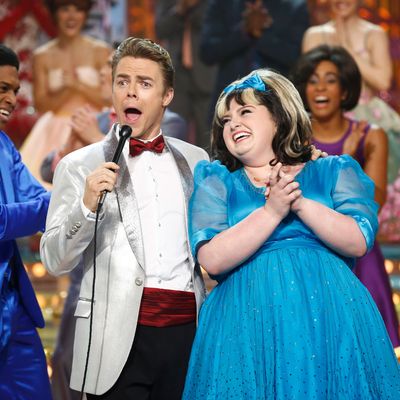
The nearly perfect 2002 stage musical Hairspray is so hardy you don’t notice how carefully it’s crafted. The score, by Marc Shaiman and Scott Wittman, is of course part of that, bringing to American pop circa 1962 a level of wit and polish hardly ever experienced in situ. If you sing the songs accurately they’re almost impossible to screw up. But the book and staging also contribute crucially, tempering the downmarket camp of the 1988 John Waters original with moral uplift and confident high spirits. What a difficult titration! Indeed, the Broadway production has not yet been equaled elsewhere: not onstage or in the 2007 movie version starring John Travolta or now in the pleasant, but not arresting, television adaption that was broadcast on NBC last night. Hairspray Live! (as I suppose we must call it even now that it’s dead) was a good-enough version of a show that, in its bones, needs to be great.
This was not a matter of fidelity; in any event, recent television musicals have demonstrated that a faithful adaptation of a stage work may be a dud (The Sound of Music) while a rethought version of even a mediocre show (Grease) may sparkle. Hairspray Live! was the faithful kind, hewing closely to the script and tune stack of the Broadway production with only one major song deletion (the second-act opener “Big Doll House,” unnecessary in a production with no second act) and one major addition (“Ladies Choice,” from the Travolta movie). Harvey Fierstein, who donned Divine’s big bra again as Edna Turnblad, also streamlined the script a bit: Gone was the never-quite-logical sequence in which Tracy, Edna’s hefty “hair-hopper” daughter, escapes from jail using a blowtorch crafted from a can of Ultra Clutch and a Zippo lighter. But it was still the story of Tracy’s attempt to break down the social barriers that keep her, and her black friends, from enjoying the full privileges of mainstream rock and roll.
Same story, same score, similar choreography (again by Jerry Mitchell), and costumes that, although new, referenced the spectacular William Ivey Long originals. So what made Hairspray Live! so much flatter than plain old Hairspray? It was mostly the limitations of the medium itself. Compared to the stage, television of course flattens everything, and when you add the full-shot clarity of HDTV, you get images that seem like frescoes. (Actually, Fierstein in his Edna drag looked like a Japanese woodcut.) Further, the camerawork of director Kenny Leon and his crew seemed skittish, in a hurry to get to the next setup, which gave the evening a nervous, jumpy feel completely at odds with the self-possession of the material. The performances, too, seemed a tad uncertain, as if underrehearsed, which may well be the case; while no one was a disaster, only those cast members already experienced onstage (Fierstein, Martin Short as Edna’s husband, Sean Hayes in a bit part, Kristin Chenoweth as the Cruella de Vil–like villain) were totally in control of their effects. And even they, but especially the rest, were often undone by muddy sound that turned key lines into garbled throwaways. Jennifer Hudson, as Motormouth Maybelle, sang fabulously, albeit in what seemed to be a different language.
To be sure, the camera’s eye allowed us to see some useful new things. When Tracy astonishes the white kids at a dance with some of the moves she’s learned from her black friends, the theme of segregation (and cultural appropriation) was perfectly encapsulated by a rope line dividing the gym by race. (Leon was able to feature it beautifully.) During the song “Welcome to the Sixties,” when Edna leaves her home for the first time since “Mamie Eisenhower rolled her hose and bobbed her bangs,” we get a real (back lot) Baltimore street, complete with moving vehicles, that visualizes her fearful yet joyful emergence into a new age. But for each of these enhancements there was a corresponding coarsening of emotional texture; the show’s heartbeat was thus erratic and intermittent. Not helping was the constant metacommentary by “host” Darren Criss, the weird product placements (for Reddi-wip and Toyota), nor the general circus feeling of the event. (As an encore, Hudson and Ariana Grande performed “Come So Far,” from the Travolta movie, as if the musical had now morphed into an episode of The Voice.) Too much commercial packaging damages Hairspray’s contents, whose countercultural vibe, while faint, runs deep. (Edna is always played by a man, for example.) Hairspray Live! honored that history with some charming Easter eggs — stores on the back-lot street included Waters Plumbing and Divine Pet Food — but for the most part neither liveness nor the television-ness was a boon. The former introduced sloppiness into material that depends on accuracy, and the latter introduced an inauthentic brand of camp. Still tasty enough, yet weirdly empty, it was a Reddi-wip evening.

